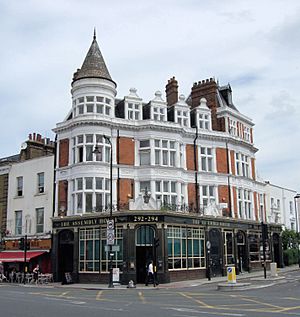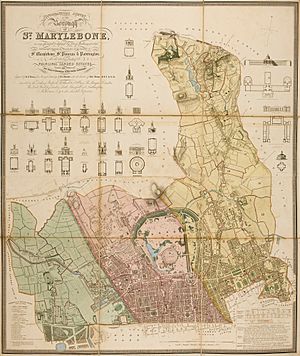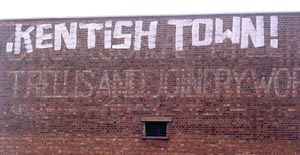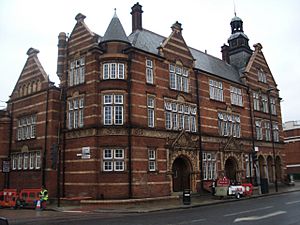Kentish Town facts for kids
Quick facts for kids Kentish Town |
|
|---|---|
 The Assembly House Pub, Kentish Town |
|
| OS grid reference | TQ285845 |
| London borough | |
| Ceremonial county | Greater London |
| Region | |
| Country | England |
| Sovereign state | United Kingdom |
| Post town | LONDON |
| Postcode district | NW5, NW1 |
| Dialling code | 020 |
| Police | Metropolitan |
| Fire | London |
| Ambulance | London |
| EU Parliament | London |
| UK Parliament |
|
| London Assembly |
|
Kentish Town is a lively area in northwest London, England. It's part of the London Borough of Camden, just north of Camden Town. This area is less than four miles from central London. It has great transport links and is close to the big open spaces of Hampstead Heath.
Kentish Town probably got its name from "Ken-ditch" or "Caen-ditch". This means "the bed of a waterway." The area started as a small settlement along the River Fleet. It was first mentioned in records way back in 1207, during the time of King John. In the early 1800s, Kentish Town became a popular place to visit. This was because it was easy to reach from London. A very famous thinker, Karl Marx, even lived here from 1856.
After World War II, Kentish Town continued to grow. It has a strong history of political leaders. For example, Keir Starmer, who became the Prime Minister of the UK in 2024, represents this area in Parliament. Kentish Town is also a popular spot for filming movies and TV shows. It's full of unique shops, music places, and cultural spots. One example is the Kentish Town Community Centre.
Contents
- What's in a Name? The Meaning of Kentish Town
- A Journey Through Time: The History of Kentish Town
- Who Lives Here? Demographics
- Lights, Camera, Action! Filming Locations
- Shopping and Community Life
- Arts and Culture
- Architecture and Location
- Famous People from Kentish Town
- Getting Around: Transport in Kentish Town
- Nearby Areas
What's in a Name? The Meaning of Kentish Town
The name Kentish Town likely comes from Ken-ditch or Caen-ditch. These words mean "the bed of a waterway." It has nothing to do with the English county of Kent. Some experts think ken is an old Celtic word for "green" or "river." The word ditch refers to the River Fleet. This river now flows underground in London.
Another idea is that the name comes from its location near the Fleet. Kentish Town sits between two parts of the Fleet. So, it might be named from cant or cantle. This is a Middle English word meaning "corner."
A Journey Through Time: The History of Kentish Town
Kentish Town began as a small village on the River Fleet. This river is now one of London's hidden underground rivers. The area was first written about in 1207 as kentisston. By 1456, Kentish Town was a busy little community. A small church was even built for the people living there.
The early 1800s brought many changes. Much of the countryside feel, the River Fleet, and old 18th-century buildings disappeared. But you can still find some old parts, like Little Green Street. Because it was easy to get to from London, Kentish Town became a popular place for people to visit.
A lot of land was bought to build the railway. You can still see these railway lines today. Kentish Town was a great spot for new buildings. This was because Kentish Town Road was a main route going north from London. Karl Marx, a famous political thinker, lived at 46 Grafton Terrace from 1856.
In 1877, community work began in the area. This was because many people there were struggling. The groups first held their meetings outside. As they got more money, they built a community house and a church. One such place was Lyndhurst Hall. It was used for many years before being taken over by the local council. The hall was later taken down in 2006.
During the 1800s and early 1900s, Kentish Town became known for making pianos and organs. In 1901, a music magazine called it "that healthy area loved by piano makers."
Street Names with History
Some streets in East Kentish Town have names linked to Christ Church, Oxford. These include Oseney, Busby, Gaisford, Caversham, Islip, Wolsey, Frideswide, Peckwater, and Hammond. All these streets are behind the Oxford Arms pub. Some of the land here is still owned by Christ Church Oxford.
Other streets in north Kentish Town were once part of a large area owned by St John's College, Cambridge. Lady Margaret Road is named after Lady Margaret Beaufort. She was the person who started St John's College. Burghley Road is named after Lord Burghley. He was an important advisor to Elizabeth I and helped St John's College. Other streets like College Lane, Evangelist Road, and Lady Somerset Road are also linked to St John's College.
Churches and Landmarks
In 1912, the Church of St. Silas the Martyr was finished. It is still standing today. You can also see the church of St Luke with St Paul. The Church of St. Barnabas was given to the Greek Orthodox Church in 1957. The main Church of England church today is St. Benet's.
The poet Sir John Betjeman wrote about "the curious Anglo-Norman parish church of Kentish Town" in his poem Parliament Hill Fields.
The Disused Tube Station
Kentish Town Road has one of London's many old, unused Tube stations. South Kentish Town tube station closed in June 1924. This happened because a strike meant the lifts couldn't work. It never reopened as a station. However, it was used as an air raid shelter during World War II. Today, the unique building is a pawn shop at street level. There have been ideas to reopen the station in the future.
After World War II, Kentish Town continued to modernize. But many of the homes, built in the mid-1800s, are still standing.
Who Lives Here? Demographics
In the 2011 census, about 53% of the people living in Kentish Town were White British. Another 15% were from other White backgrounds.
Lights, Camera, Action! Filming Locations
Kentish Town has been a popular place for filming movies and TV shows:
- In 2002, the movie About a Boy was filmed on Lady Margaret Road and Oseney Crescent.
- Many scenes for the 2006 film Venus were shot in Kentish Town. This movie starred Peter O'Toole.
- In 1959, Lady Somerset Road and Oakford Road were used for the film Sapphire. This movie looked at racial tensions in London.
- The Assembly House pub was used for the 1971 film Villain with Richard Burton.
- The 1993 comedy Bad Behaviour was set in Kentish Town. It showed scenes in local streets and the Owl Bookshop.
- The 1947 film It Always Rains on Sunday had scenes in Clarence Way. These showed Holy Trinity Church after its spire was damaged in WWII.
- The music video for the Madness song "Baggy Trousers" was filmed at Islip Street School and a park in Kentish Town.
- The Anglican Parish Church of St John Kentish Town (now "Christs Apostolic Church") was used in Only Fools and Horses. It was the outside of the church where Damien was christened.
- Many outdoor scenes in the BBC show Fleabag were filmed in Kentish Town. The show's writer and star, Phoebe Waller-Bridge, lives in the area.
Shopping and Community Life
In 2005, a local survey found that many shops on Kentish Town Road were still owned by local people. The street has a mix of big chain stores and unique independent shops. These include a long-standing bookshop and several organic food stores. Many "World Food" shops have also opened. However, since 2009, more chain stores like Pret a Manger and Sainsbury's have moved in.
Kentish Town Community Centre
The Kentish Town Community Centre opened in 2004. It provides places for meetings and activities for local people of all ages.
Arts and Culture
Kentish Town is famous for its music scene. Pub rock music started at the "Tally Ho" pub in Kentish Town in 1971. Bands like Eggs over Easy and Brinsley Schwarz played there. The Assembly House is a beautiful old pub built in the 1800s.
Kentish Town is also home to The Forum. This building was once a cinema in the 1950s. Now, it's a popular live music venue. In 2014, Kentish Town got its first hidden "speak easy" bar, Knowhere Special. It opened next to Kentish Town station.
Torriano Avenue, built in 1848, is a historic street in Kentish Town. It's home to Pete Stanley, a famous banjo player. The British actor Bill Nighy also lives here. The Torriano Poets have met here for over 20 years. They still hold public poetry readings on Sunday evenings. The street also has two pubs, The Leighton and The Torriano. These pubs are named after the landowners who developed the area in the mid-1800s.
Kentish Town Sports Centre
The biggest public building is the Kentish Town Sports Centre. It opened in 1903 as the St Pancras public baths. It was designed by Thomas W. Aldwinckle. The large building originally had separate baths for men and women, plus a public hall. Not much of the original inside remains. The baths closed in 2007 for updates and reopened in July 2010.
Architecture and Location
Kentish Town covers a fairly large area. It stretches from Camden Gardens north to the Highgate Road/Gordon House Road junction. Kentish Town generally includes areas to the west, around Queens Crescent, and to the east, around Torriano.
Famous People from Kentish Town
- Akala, rapper
- Ben Aaronovitch, writer
- Kingsley Ben-Adir, actor
- Siân Berry, Green Party politician
- Archie Bland, journalist
- Tom Conti, actor
- Charles Dance, actor
- Hunter Davies, writer
- Simon Day, comedian
- Noel Fielding, comedian
- Margaret Forster, writer
- Ben Goldacre, doctor and journalist
- Eddy Grant, musician
- William Harrison, singer and actor
- Patricia Hewitt, former government minister
- Tom Hiddleston, actor
- Leigh Hunt, 19th century writer
- Bert Jansch, folk musician
- Daniel Kaluuya, actor
- Tim Key, comedian and poet
- Roger Lloyd-Pack, actor
- Karl Marx, famous political philosopher
- Tobias Menzies, actor
- Scott Mills, radio DJ
- Mae Muller, singer
- Bill Nighy, actor
- George Orwell, writer
- Gareth Peirce, solicitor
- Lucy Porter, comedian
- Alan Rusbridger, newspaper editor
- Jon Snow, TV journalist
- Keir Starmer, Prime Minister of the United Kingdom
- Jim Sturgess, actor and musician
- Phoebe Waller-Bridge, writer and actress
Getting Around: Transport in Kentish Town
Kentish Town has many ways to get around. It has a mainline railway station served by Thameslink. This station also connects to the London Underground. There are other Underground stations nearby. You can also find overground train connections at Kentish Town West and Camden Road stations. Many bus routes serve the area, with most going into or around Central London.
Bus Routes
The following bus routes serve Kentish Town: 88 (runs 24 hours), 134 (runs 24 hours), 214 (runs 24 hours), 393, and Night Bus Route N20.
Nearest Stations
- Kentish Town station
- Gospel Oak railway station
- Kentish Town West railway station
- Camden Road railway station
- Camden Town tube station
- Caledonian Road tube station
Nearby Areas
- Camden Town and Chalk Farm are to the south.
- Barnsbury is to the south-east.
- Tufnell Park and Holloway are to the east.
- Dartmouth Park and Archway are to the north-east.
- Highgate is to the north.
- Hampstead and Belsize Park are to the west.





